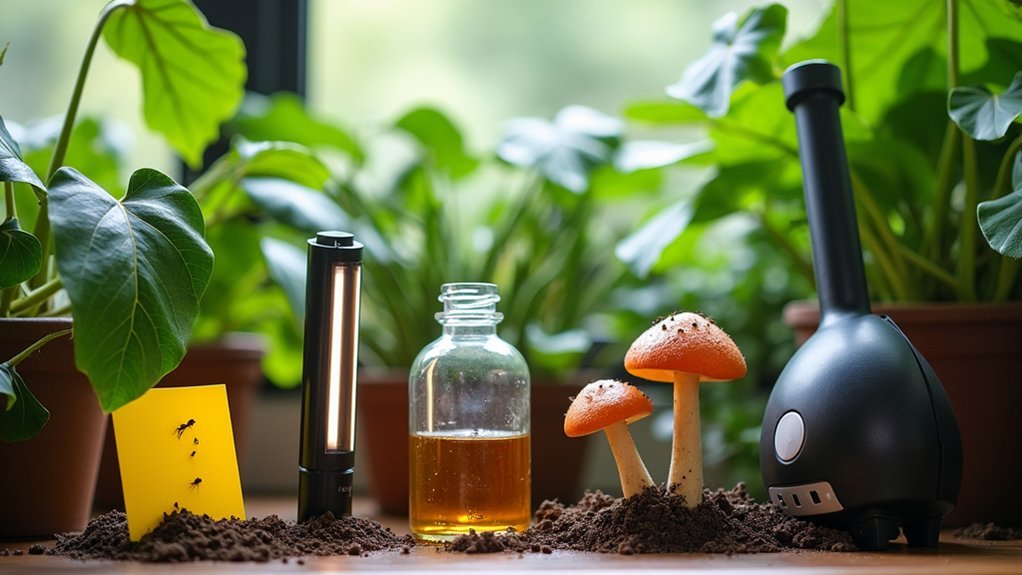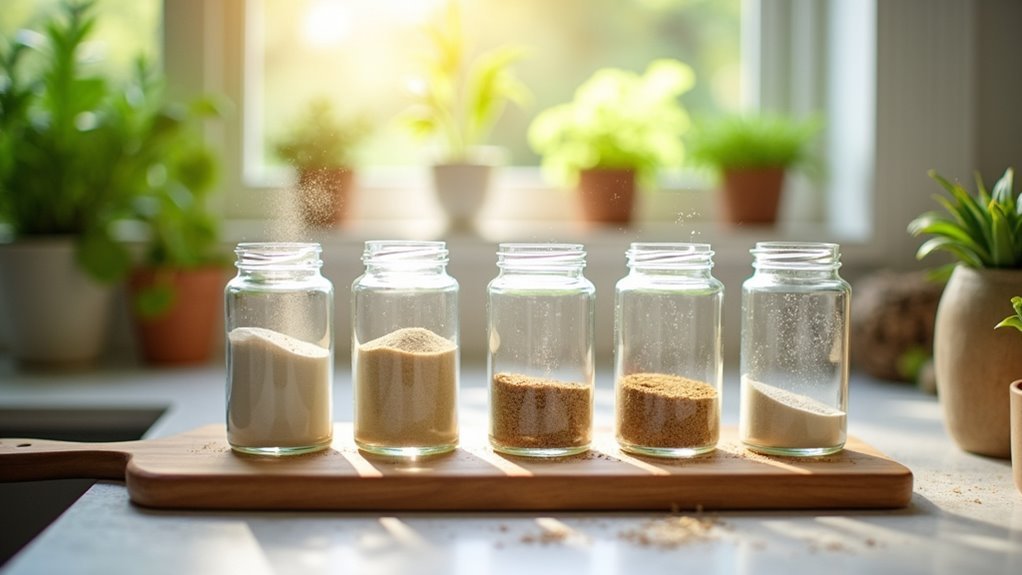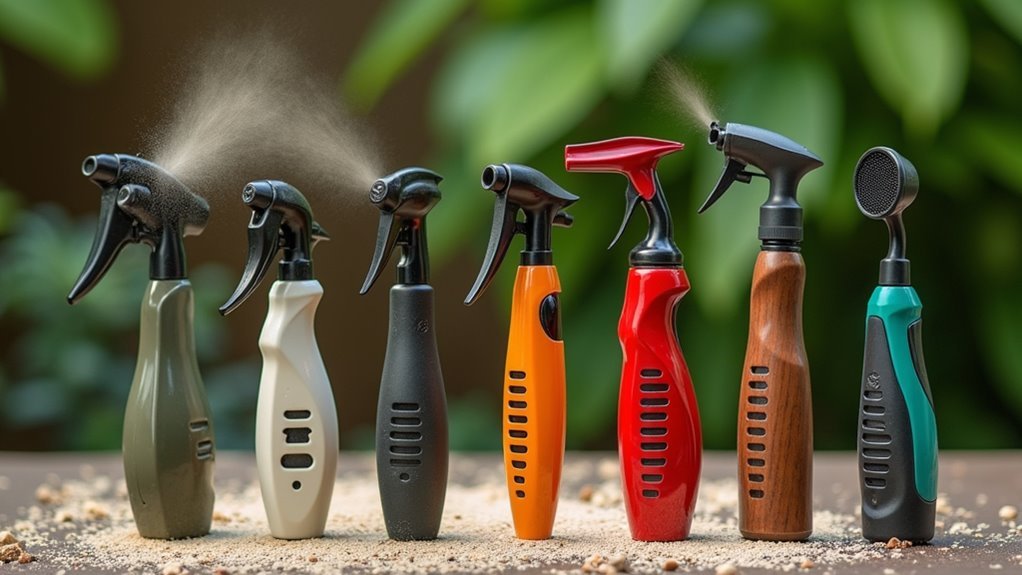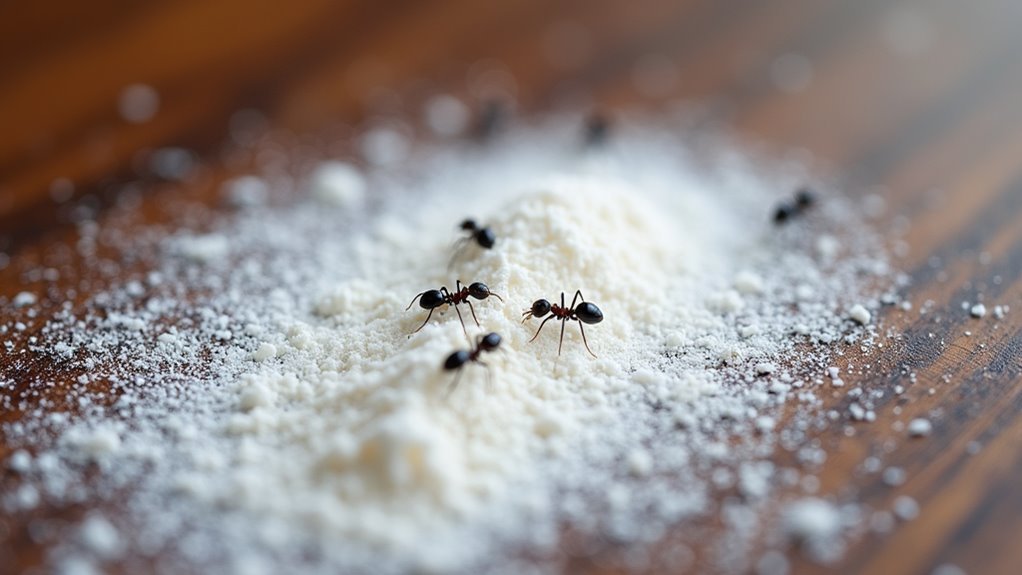If you’ve noticed tiny flying insects hovering around your beloved houseplants, you’re dealing with a common indoor gardening nuisance—gnats. These persistent pests can quickly multiply and wreak havoc on your plant collection. Fortunately, effective trapping solutions exist that won’t harm your greenery or require harsh chemicals. The right gnat trap can mean the difference between a thriving indoor garden and a frustrating battle against these minuscule invaders. Let’s explore options that actually work for houseplant enthusiasts like you.
Sticky Trapz Yellow Plant Traps for Gnats and Insects (64 Pcs)
Houseplant enthusiasts battling persistent flying pests will find Sticky Trapz an essential defense system. These double-sided yellow traps effectively capture gnats, fruit flies, aphids, and other common indoor plant nuisances.
You’ll appreciate the thoughtful design—no hooks or strings needed, just insert directly into soil. The package includes 64 traps and two small shovels for easy installation. Their butterfly and flower shapes add aesthetic appeal rather than detracting from your plant display.
Made with eco-friendly materials and non-toxic adhesive, they’re safe around children and pets. With an impressive 4.7-star rating from over 2,300 customers, these traps deliver meaningful results for your indoor garden.
Best For: Indoor plant owners struggling with fungus gnats, fruit flies, and other flying pests who want an effective, eco-friendly solution that doesn’t compromise plant aesthetics.
Pros:
- Double-sided sticky traps with 64 pieces provide long-lasting protection against multiple flying pest species without chemicals
- Attractive butterfly and flower shapes blend seamlessly with houseplants, unlike standard yellow rectangles
- Simple soil insertion design requires no hanging or additional hardware, and includes soil shovels for easy installation
Cons:
- May accidentally catch beneficial insects if used outdoors in garden spaces
- Requires regular replacement once filled with insects or when the adhesive becomes less effective
- Some users might find positioning tricky to avoid contact with plant leaves, which could cause damage
Fungus Gnat Traps for Indoor Plants (40 Pack Yellow Sticky Traps)
Yellow sticky traps offer a chemical-free solution for indoor gardeners battling persistent fungus gnat infestations. With a 4.5-star rating from over 10,000 customers, these Dwcom Traps effectively capture gnats, fruit flies, whiteflies, and other pests.
You’ll appreciate the straightforward design—just remove the protective film, peel the backing, and insert directly into soil. The bright yellow color naturally attracts flying insects while the strong, waterproof adhesive holds them securely.
Unlike chemical alternatives, these traps use no harmful substances, making them safe around people and pets. They’ll remain effective until completely covered with insects.
Best For: Indoor plant enthusiasts dealing with fungus gnats and other flying pests who prefer a chemical-free pest control solution that’s safe around family and pets.
Pros:
- Highly effective trap design with bright yellow color and strong adhesive that captures multiple flying pest species
- Easy to use with straightforward installation directly into soil without requiring additional hooks or tools
- Safe, chemical-free pest control solution with no harmful odors or substances
Cons:
- Some users report difficulty removing the protective backing from the sticky traps
- May lack stability in certain potting arrangements or with larger plants
- Being made of paper, the traps may deteriorate faster in very humid environments or when frequently watered
Fruit Fly Trap Indoor Sticky Traps (36 Pack)
Plant lovers struggling with persistent flying pests will find immediate relief with these highly-rated sticky traps from Stingmon. The bright yellow 5.5 x 4-inch cards attract insects while strong adhesive guarantees they can’t escape.
You’ll appreciate how easily these traps work—simply peel off the protective film and insert the sharp bottom directly into soil. No hooks or ropes needed. They’re non-toxic, odorless, and completely safe around people and pets.
With over 33,000 positive reviews and a 4.4-star rating, these UV-resistant traps effectively target fungus gnats, fruit flies, and mosquitoes. For best results in warm weather, refrigerate before using to prevent melting glue.
Best For: Indoor plant enthusiasts battling fungus gnats, fruit flies, mosquitoes, and other flying pests that threaten the health of houseplants.
Pros:
- Simple design with sharp bottom allows direct insertion into soil without needing additional hooks or ropes
- Non-toxic, odorless formula makes them safe for use around children and pets
- Bright yellow color and strong adhesive effectively attracts and traps multiple types of flying insects
Cons:
- Adhesive can get on fingers during installation if protective film isn’t removed carefully
- Glue may melt in warm temperatures, requiring refrigeration before use
- Some customers found the traps less attractive to certain insects than expected, though still generally effective
Kates Home & Garden Plant Spray for Insects with Sticky Traps
For dedicated plant enthusiasts struggling with multiple pest problems, Kates Home & Garden offers a thorough solution that combines immediate intervention with ongoing protection. This 16oz spray tackles fungus gnats, spider mites, and fruit flies using natural peppermint and rosemary oils instead of harsh chemicals.
You’ll appreciate the non-toxic formula that’s safe around children and pets when used as directed. The bundle includes 12 sticky traps to enhance your pest management strategy.
Application is straightforward—shake well, test on a few leaves first, then spray plants and soil thoroughly to target pests at all life stages. With weekly use, one bottle provides up to 1,500 applications.
Best For: Plant lovers seeking a complete, natural solution to combat multiple indoor and outdoor pest problems without using harsh chemicals around children and pets.
Pros:
- Comprehensive pest control with dual-action approach of spray and sticky traps for immediate and ongoing protection
- Natural peppermint and rosemary oil formula provides a safe alternative to chemical pesticides
- Versatile application for multiple pest types including fungus gnats, spider mites, and fruit flies
Cons:
- Requires weekly application for optimal effectiveness, which may be time-consuming for those with many plants
- Need to test on a few leaves first and wait 6 hours before full application adds an extra step
- May not be as immediately effective against severe infestations as chemical alternatives
Sticky Trapz Yellow Plant Traps for Gnats (64 Pcs)
Indoor gardeners struggling with persistent flying pests will find Sticky Trapz an effective solution. These double-sided yellow cards attract and capture gnats, fruit flies, aphids, and other unwanted visitors with their bright color and strong adhesive.
You’ll appreciate the thoughtful design—resembling flowers and butterflies—which blends naturally with your plants. Simply insert them directly into soil without hooks or ropes. The package includes 64 traps and two mini shovels for easier placement.
Made with eco-friendly, non-toxic materials, they’re safe around people and pets. With an impressive 4.7-star rating from over 2,300 customers, these traps deliver noticeable results for both indoor and outdoor plants.
Best For: Indoor plant enthusiasts dealing with fungus gnats, fruit flies, and other flying pests who want an effective, visually appealing, and non-toxic pest control solution.
Pros:
- Double-sided sticky cards with strong adhesive effectively trap multiple types of flying insects without chemicals
- Decorative flower and butterfly designs blend aesthetically with plants while serving a practical purpose
- Package includes 64 traps and two mini shovels, offering excellent value and convenience for multiple plants
Cons:
- May accidentally trap beneficial insects when used outdoors
- Sticky traps require replacement once full of insects, creating ongoing waste
- Some users might find placement challenging without damaging plant leaves
Factors to Consider When Choosing the Most Effective Gnat Traps for Houseplant Enthusiasts
When choosing gnat traps for your houseplants, you’ll need to evaluate several key factors that determine effectiveness. Consider the trap design, glue strength, quantity per package versus actual coverage area, pet-safety of materials, and how easily you can install them around your plants. These considerations will help you select traps that adequately protect your indoor garden while maintaining safety for your household.
Trap Design Options
Several key design features differentiate the most effective gnat traps from their less successful counterparts. Double-sided sticky cards give you twice the capturing power, attracting insects from multiple angles to maximize effectiveness. Bright yellow designs prove particularly irresistible to gnats and fruit flies, drawing them in more effectively than other colors.
You’ll find convenient installation options like sharp-bottom traps that insert directly into soil without needing hooks or ropes. This saves time while ensuring ideal placement near infestation sources.
For the environmentally conscious plant owner, look for traps made from eco-friendly materials that won’t harm your plants or introduce toxins into your home. Some manufacturers even offer decorative designs resembling flowers or butterflies, allowing your pest control solution to blend seamlessly with your indoor garden aesthetic.
Glue Strength Assessment
Beyond the physical design of your trap, the adhesive quality can make or break your gnat-catching success. The strongest glues guarantee gnats remain trapped upon contact, preventing any chance of escape. When selecting traps, look for products featuring UV-resistant and waterproof adhesives that maintain effectiveness regardless of humidity levels or sunlight exposure.
High-quality adhesive traps require replacement only when their surfaces become fully covered with insects, saving you both time and money. Prioritize non-toxic, odorless formulations that won’t harm your plants or pose risks to pets and family members.
Customer reviews consistently highlight adhesive strength as the defining factor in trap performance. The most effective products maintain their stickiness over extended periods, allowing for continuous protection of your houseplants against persistent gnat infestations.
Quantity vs. Coverage
Finding the right balance between trap quantity and coverage area represents a crucial decision for houseplant enthusiasts battling gnat infestations. When shopping for gnat traps, pay attention to package quantities—more traps mean better coverage for larger plant collections or extensive infestations.
Strategic placement is key. You’ll want to distribute traps throughout your plant area, placing them near soil surfaces and around plant clusters where gnats congregate. Consider trap dimensions too; larger traps cover more area individually, while smaller ones might require greater numbers for equivalent protection.
Assess your specific situation carefully. Dense arrangements of houseplants typically need more traps than sparse collections. Keep track of how many traps you’ve used and their effectiveness to optimize future purchases. This helps you maintain just the right quantity for your unique houseplant environment.
Pet-Safe Material Composition
While protecting your cherished houseplants from gnats remains the primary goal, ensuring the safety of your furry companions deserves equal attention. When selecting gnat traps, prioritize products made from eco-friendly materials that won’t harm your pets or the environment.
Look for traps featuring non-toxic, odorless adhesives—these effectively capture gnats without posing risks to curious cats or dogs that might investigate them. The best options explicitly state their pet-friendly status on packaging, giving you peace of mind about their household safety.
High-quality adhesives should be strong enough to prevent gnats from escaping while remaining safe for home use. Before purchasing, review customer feedback specifically addressing pet safety experiences, as these real-world insights often reveal how well traps perform in homes where pets roam freely.
Ease of Installation
Once you’ve selected pet-friendly gnat traps, the next consideration is how easily you can set them up around your beloved houseplants. Look for traps with sharp bottom designs that insert directly into soil—these eliminate the need for hooks or ropes and provide immediate stability.
Many modern traps come ready to use; simply remove the protective film from sticky surfaces and place them strategically. The lightweight, compact nature of quality traps allows you to position them without disturbing your plants’ growth or appearance.
Some manufacturers include helpful tools like mini shovels to simplify soil manipulation during installation. This thoughtful addition makes the process nearly effortless, even if you’re new to houseplant care. Clear instructions guarantee you’ll position traps correctly for maximum effectiveness, giving you confidence that you’ve installed your gnat defense system properly.
Indoor/Outdoor Versatility
Although many homeowners purchase gnat traps specifically for indoor plants, the most valuable options offer flexibility for both indoor and outdoor use. When selecting your traps, look for products that can adapt seamlessly between your kitchen windowsill, greenhouse, and garden beds.
Indoor-friendly traps should be discreet and safe around family and pets, while outdoor versions need durability against moisture and UV exposure. The best traps work effectively in multiple locations—whether inserted directly into potting soil or positioned around your favorite plants.
You’ll want traps with strong adhesive properties that attract various flying pests, not just gnats. This versatility guarantees you’re getting maximum value from your purchase, as you can address pest problems wherever they occur without buying separate solutions for different environments.
Environmental Impact Analysis
When selecting gnat traps for your houseplants, considering environmental impact should be a priority alongside effectiveness. Eco-friendly options made from natural materials with non-toxic adhesives guarantee safety for your family, pets, and the broader environment.
Look for traps featuring bright yellow colors that naturally attract gnats, reducing the need for harmful chemical repellents. The best options use odorless adhesives that won’t compromise your indoor air quality while effectively capturing pests.
Consider investing in reusable or long-lasting traps to minimize waste and reduce your environmental footprint over time. Many aesthetically pleasing designs resemble natural elements like flowers or butterflies, allowing them to blend seamlessly with your indoor garden while serving their practical purpose.
Frequently Asked Questions
How Often Should I Replace Sticky Traps in My Houseplants?
Replace sticky traps in your houseplants every 2-4 weeks, or sooner if they’re filled with gnats. You’ll know it’s time when they’re visibly covered or have lost their stickiness.
Can Gnat Traps Harm Beneficial Insects in My Indoor Garden?
Yes, sticky traps don’t discriminate between pests and beneficial insects. If you’re using biological controls like predatory mites or beneficial nematodes indoors, your traps might catch them too. Place traps strategically to minimize this risk.
What Preventive Measures Work Alongside Traps to Eliminate Gnats Permanently?
You’ll eliminate gnats permanently by letting soil dry between waterings, removing dead plant material, applying diatomaceous earth, using bottom watering techniques, and adding beneficial nematodes to soil. Traps work better with these preventive measures.
Are Homemade Gnat Trap Alternatives as Effective as Commercial Products?
Homemade traps like apple cider vinegar and soap solutions work well, but they’re typically less potent than commercial options. You’ll get decent results with DIY methods, though store-bought traps offer more consistent and thorough elimination.
Do Different Colored Traps Attract Different Types of Houseplant Pests?
Yes, trap colors matter! Yellow attracts fungus gnats and whiteflies, while blue lures thrips and leafminers. Red and black can capture spider mites. You’ll catch more pests by choosing the right color for your specific problem.





Leave a Reply